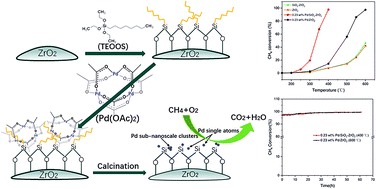当前位置:
X-MOL 学术
›
J. Mater. Chem. A
›
论文详情
Our official English website, www.x-mol.net, welcomes your feedback! (Note: you will need to create a separate account there.)
Atomically dispersed palladium-based catalysts obtained via constructing a spatial structure with high performance for lean methane combustion
Journal of Materials Chemistry A ( IF 11.9 ) Pub Date : 2020/04/03 , DOI: 10.1039/c9ta13574j Qiuyan Duan 1, 2, 3, 4, 5 , Chenghua Zhang 5, 6, 7, 8, 9 , Song Sun 4, 5, 10, 11, 12 , Yang Pan 3, 4, 5, 12 , Xiong Zhou 5, 13, 14, 15 , Yang Liu 1, 2, 3, 4, 5 , Kun Chen 1, 2, 3, 4, 5 , Cunshuo Li 1, 2, 3, 4, 5 , Xianzhou Wang 5, 6, 7, 8, 9 , Wenzhi Li 1, 2, 3, 4, 5
Journal of Materials Chemistry A ( IF 11.9 ) Pub Date : 2020/04/03 , DOI: 10.1039/c9ta13574j Qiuyan Duan 1, 2, 3, 4, 5 , Chenghua Zhang 5, 6, 7, 8, 9 , Song Sun 4, 5, 10, 11, 12 , Yang Pan 3, 4, 5, 12 , Xiong Zhou 5, 13, 14, 15 , Yang Liu 1, 2, 3, 4, 5 , Kun Chen 1, 2, 3, 4, 5 , Cunshuo Li 1, 2, 3, 4, 5 , Xianzhou Wang 5, 6, 7, 8, 9 , Wenzhi Li 1, 2, 3, 4, 5
Affiliation

|
Lean methane combustion through efficient catalysis is an intensely important way to reduce environmental pollution. Notably, palladium-based catalysts are promising catalytic materials. The small size of palladium particles is a crucial factor to improve the catalytic activity. In this study, we proposed a new pathway to minimize the size of palladium particles for palladium-based catalysts from the perspective of material preparation. We first built double spatial barriers on the interface between the support and the active species to prepare atomically dispersed palladium species catalysts. To be specific, organo-silane was employed as a surfactant to modify the zirconia support and palladium acetate was selected as the palladium precursor, taking advantage of the spatial structure of alkane chains combined with silicon atoms and palladium acetate in toluene. Under a lean methane reaction environment, 0.23 wt% atomically dispersed palladium species deposited on decorated zirconia (donated as 0.23 wt% Pd/SiO2–ZrO2) displayed high catalytic activity with 100% conversion at a temperature of around 400 °C with gas hourly space velocity (GHSV) of 30 000 ml g−1 h−1, higher than that of pristine zirconia loaded with 0.23 wt% palladium nanoparticles (donated as 0.23 wt% Pd/ZrO2), which removed all lean methane at around 600 °C under the same conditions. As the palladium loading increased on the modified support, the 1.38 wt% Pd/SiO2–ZrO2 catalyst had a comparable catalytic activity and fully converted lean methane at around 330 °C. The lean methane combustion reaction pathway for the 0.23 wt% Pd/SiO2–ZrO2 catalyst was investigated by in situ NAP-XPS and in situ DRIFTS. Hydroxyl groups formed during the reaction were transferred to the silica, which could reduce the formation of the inactive Pd(OH)x species and expose more active sites to improve the catalytic activity. It is hoped that this study will provide a novel method to improve the utilization of palladium species in practical applications.
中文翻译:

通过构建对贫甲烷燃烧具有高性能的空间结构而获得的原子分散钯基催化剂
通过有效催化实现贫甲烷燃烧是减少环境污染的极为重要的方法。值得注意的是,钯基催化剂是有前途的催化材料。钯颗粒的小尺寸是提高催化活性的关键因素。在这项研究中,我们从材料制备的角度提出了一条新的途径,以最小化钯基催化剂的钯颗粒尺寸。我们首先在载体和活性物种之间的界面上建立了双重空间屏障,以制备原子分散的钯物种催化剂。具体而言,将有机硅烷用作表面活性剂以改性氧化锆载体,并选择乙酸钯作为钯前体,利用烷烃链与硅原子和乙酸钯结合的甲苯空间结构。在贫甲烷反应环境下,0.23 wt%原子分散的钯物质沉积在装饰的氧化锆上(捐赠为0.23 wt%Pd / SiO2 -ZrO 2)在约400°C的温度下显示出高催化活性,并具有100%的转化率,气体时空速(GHSV)为30000 ml g -1 h -1,高于负载0.23 wt百分比的钯纳米粒子(捐赠为0.23重量%Pd / ZrO 2),在相同条件下于600°C左右除去了所有贫甲烷。随着改性载体上钯载量的增加,1.38 wt%的Pd / SiO 2 -ZrO 2催化剂具有可比的催化活性,并在约330°C时完全转化为贫甲烷。Pd / SiO 2 -ZrO 2为0.23 wt%的稀甲烷燃烧反应路径催化剂通过原位NAP-XPS和原位DRIFTS研究。反应期间形成的羟基被转移到二氧化硅上,这可以减少非活性Pd(OH)x物种的形成并暴露更多的活性位点以提高催化活性。希望这项研究将提供一种新颖的方法来提高实际应用中钯物种的利用率。
更新日期:2020-04-15
中文翻译:

通过构建对贫甲烷燃烧具有高性能的空间结构而获得的原子分散钯基催化剂
通过有效催化实现贫甲烷燃烧是减少环境污染的极为重要的方法。值得注意的是,钯基催化剂是有前途的催化材料。钯颗粒的小尺寸是提高催化活性的关键因素。在这项研究中,我们从材料制备的角度提出了一条新的途径,以最小化钯基催化剂的钯颗粒尺寸。我们首先在载体和活性物种之间的界面上建立了双重空间屏障,以制备原子分散的钯物种催化剂。具体而言,将有机硅烷用作表面活性剂以改性氧化锆载体,并选择乙酸钯作为钯前体,利用烷烃链与硅原子和乙酸钯结合的甲苯空间结构。在贫甲烷反应环境下,0.23 wt%原子分散的钯物质沉积在装饰的氧化锆上(捐赠为0.23 wt%Pd / SiO2 -ZrO 2)在约400°C的温度下显示出高催化活性,并具有100%的转化率,气体时空速(GHSV)为30000 ml g -1 h -1,高于负载0.23 wt百分比的钯纳米粒子(捐赠为0.23重量%Pd / ZrO 2),在相同条件下于600°C左右除去了所有贫甲烷。随着改性载体上钯载量的增加,1.38 wt%的Pd / SiO 2 -ZrO 2催化剂具有可比的催化活性,并在约330°C时完全转化为贫甲烷。Pd / SiO 2 -ZrO 2为0.23 wt%的稀甲烷燃烧反应路径催化剂通过原位NAP-XPS和原位DRIFTS研究。反应期间形成的羟基被转移到二氧化硅上,这可以减少非活性Pd(OH)x物种的形成并暴露更多的活性位点以提高催化活性。希望这项研究将提供一种新颖的方法来提高实际应用中钯物种的利用率。



























 京公网安备 11010802027423号
京公网安备 11010802027423号